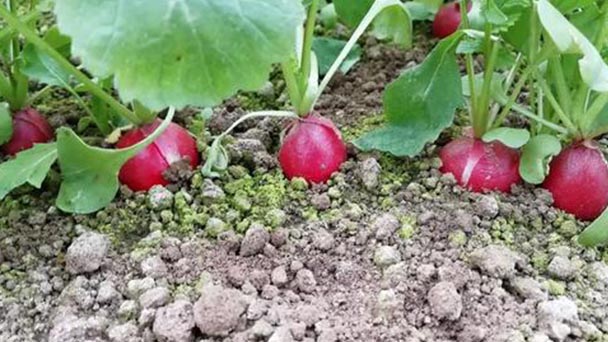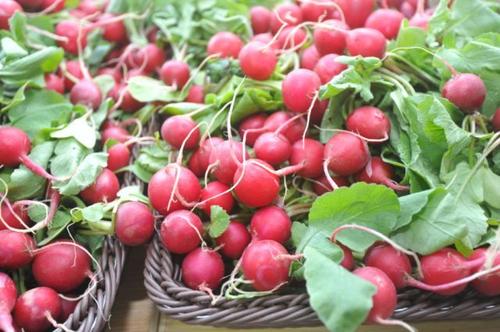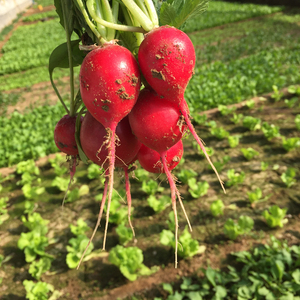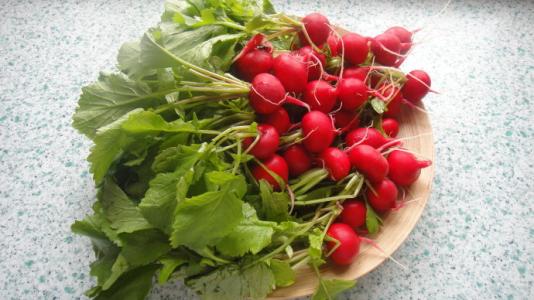Cultivated radish profile
Written by Maggie
Jan 28 2021

Cultivated radish, scientific name Raphanus sativus, has the characteristics of fine quality, rapid growth, beautiful appearance and color, suitable for eating raw.
Cultivated radish picture

Morphological characteristics of cultivated radish
Cultivated radish (Raphanus sativus) is a small radish, delicate in quality, fast in growth, beautiful in color, round in flesh, 2-3cm in diameter, 15-20g in weight per plant, red in rind and white in flesh, 30-40 days in growth period, adaptable, fond of mild climate conditions, not resistant to heat, suitable for raw eating.
Cultivated radish (Raphanus sativus) is a biennial or annual crop of the Cruciferae genus Radish that can form fleshy roots. Cultivated radish is mainly divided into Chinese radish and radish four seasons in two categories. Cultivated radish belongs to the radish group of four seasons.
Cultivated radish (Raphanus sativus) is a straight root system with a taproot penetration depth of about 60-150 cm, and the main root groups are distributed in the soil layer of 20-45 cm. Fleshy roots are nutrient storage organs, most of which are round or oblate, with red or white epidermis and white flesh. The hypocotyl and the upper part of the Cultivated radish swell to form fleshy roots. Fleshy roots have spherical, oblate, oval, spindle, conical, etc. Skin color has red, white and red next white three colors. Flesh color of Cultivated radish is white, single root weight from ten grams to dozens of grams.
Cultivated radish's leaves are clustered on shortening stems during vegetative growth and are either platyleaf or Mosaic, dark green or green. Petiole and vein for green, individual purple, on downy hair. After the temperature and photoperiod, the main flower stem was extracted from the terminal bud, and the lateral flower branches occurred between the axils of the main flower stem. Cultivated radish is a racemose inflorescence with 4 petals arranged in a cross. The color is white and lavender. Fruit for pod fruit, mature when not dehiscence, seed oblate round, light yellow or dark brown. The germinability of Cultivated radish seeds can be maintained for 5 years, but the growth potential will be reduced due to long-term preservation, so it is appropriate to use 1-2 years of seeds as seeds in production.
Cultivated radish (Raphanus sativus) stem is shortening in the vegetative growth period, into the reproductive growth period of raw flower stem. Cotyledons 2, reniform. The first pair of its leaf spoon shape, said primary leaves. The leaves that grow later in the vegetative growth period are collectively called rosettes. The leaf shape of Cultivated radish has the plate leaf and the pinnately cleft leaf. The leaf color has light green, dark green and other colors, petiole has green, red, purple and other colors.
Flowers of Cultivated radish (Raphanus sativus) are complex racemes, complete flowers. Calyx and corolla are cruciform. Long horny fruit, containing 3 to 8 seeds. The seed of Cultivated radish is irregular round, the seed coat is yellow to dark brown.
Cultivated radish distribution range
Cultivated radish (Raphanus sativus) is most cultivated in China and is imported from Japan, Germany and other countries. Yangzhou Radish is the most famous Radish cultivated in China.

Cultivated radish growing methods
Cultivated radish (Raphanus sativus) is not strict with environmental conditions and is highly adaptable.
The temperature
Cultivated radish (Raphanus sativus) originated in a temperate zone, as a semi - cold - resistant vegetable. The suitable temperature range for growth is 5 ~ 25℃. The optimum temperature for Cultivated radish seed germination was 20 ~ 25℃, the optimum temperature for seed growth was about 20℃, and the optimum temperature for succulent root expansion was 6 ~ 20℃, which was slightly lower than the optimum temperature for succulent root growth. Under 6℃, the growth is slow, easy to pass the vernalization stage, resulting in immature lichen. Fleshy roots of Cultivated radish suffer from freezing damage below 0℃. When the temperature is higher than 25℃, respiration consumption increases, organic matter accumulation is less, plant growth is weak, prone to disease, fleshy root fiber increases, quality becomes worse. The optimum temperature for Cultivated radish flowering is 16 ~ 22℃.
Illumination
Cultivated radish (Raphanus sativus) is strict to the illumination requirement. In the growth process, the required light and insufficient light affect the accumulation of photosynthate, fleshy root enlargement is slow, decreased, and the quality becomes poor. Cultivated radish is a long sunshine crop, in more than 12 hours of sunshine can enter the flowering period.
Moisture
The growing process of Cultivated radish (Raphanus sativus) requires an even water supply. In the germination period and seedling period, water is not much, only to ensure the water requirements of seed germination and ensure soil moisture. Small water should be frequently irrigated Cultivated radish growth peak, large leaves, strong transpiration, drought tolerance, the maximum requirement of soil moisture capacity of 60% ~ 80%. If water is insufficient, fleshy root moisture content is less, easy to burn heart, reduce the Cultivated radish content of vitamin C. Long-term drought, fleshy root growth is slow, fibrous root increase, rough quality, spicy taste. Soil moisture is too much, ventilation is bad, fleshy root epidermis is rough, and also affects quality.
Soil
Cultivated radish (Raphanus sativus) is not strict about soil conditions. But deep soil layer, water retention, good drainage, loose and breathable sandy loam is suitable. Cultivated radish like potash fertilizer, increased potassium fertilizer, with nitrogen, phosphate fertilizer, can be high quality yield. Cultivated radish likes sandy loam with good water retention and drainage and loose ventilation. The moisture content of soil is 20%. Soil moisture is one of the important factors affecting the yield and quality of Cultivated radish. Especially in the formation stage of fleshy roots, soil water shortage affects the enlargement of fleshy roots, the increase of fibrous roots, the rough skin, the increase of spicy taste, the decrease of sugar and vitamin C content, easy to hollow. If the soil moisture content is high, the soil aeration is poor, fleshy root lenticels increase and become rough; A number of wet uneven, it is easy to crack the root.
The main value of cultivated radish
Cultivated radish (Raphanus sativus) contains a variety of mineral elements, trace elements and vitamins, amylase, glucose, adenosin oxidase, glycase, choline, mustard oil, and other ingredients. Cultivated radish is crisp and tender in texture, sweet in taste, and lighter in spicy flavor than large Cultivated radish. Cultivated radish (Raphanus sativus) is suitable for eating raw Radish, and can promote gastrointestinal peristalsis, increase appetite, and help digestion.

Latest Updated
- Benefits of Bugleweed - 7 Science-backed Health Benefits
- Bugleweed Dangers & Side Effects - Is It Poisonous?
- How to Plant Evergreen Trees - What You Should Know
- When to Plant Evergreens - Grow Guide for Evergreen Trees
- 12 Wonderful Evergreen Shrubs for Your Garden
- 12 Popular Evergreen Plants with Pictures for Beginners
- When And How To Prune A Lilac Bush Like a Pro
- How to Grow & Care for Lilac Vine (Hardenbergia Violacea)
- Japanese Lilac Tree (Syringa Reticulata) Care & Propagation Guide
- Shumard Oak Pros and Cons - What to Know
Popular Articles
- Winter maintenance of Antirrhinum Majus
- How to Grow Terminalia Mantaly Tree
- How to Grow and Care for Crossostephium Chinense
- How to grow Antirrhinum Majus in spring
- Peristeria Elata (Dove Orchid) Profile: Info & Care Guide
- Underwatered Snake Plant (Sansevieria Trifasciata) - Signs And How To Fix
- How to Care for Brazilian Jasmine Plant (Mandevilla Sanderi)
- How to Grow & Care for Graptopetalum Purple Delight in Summer
- Rosa Chinensis (China Rose): Plant Growing & Care Tips
- How to Care for Baby Sun Rose (Aptenia Cordifolia)